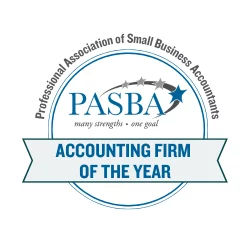Explore SECURE Act 2.0 retirement benefits tax credits for small businesses. Get expert advice from J.R. Martin & Associates for optimal planning.
The Expanding Retirement Benefits Of SECURE Act 2.0 Tax Credit
The Setting Every Community Up for Retirement Enhancement (SECURE) Act was passed in December 2019 to expand retirement benefits and increase access to tax-advantaged savings plans. This expansion was motivated by the rising concern among Americans over their lack of retirement savings.
The SECURE Act included several provisions to address these concerns, including a tax credit for small businesses offering retirement plans to their employees.
However, the problem has continued to persist. The 2022 Survey of Consumer Finances revealed that almost 50% of American households had no savings in retirement accounts.
In 2024, AARP published a survey revealing that 20% of adults aged 50 and above have zero retirement savings. Additionally, the survey found that over half (61%) of these individuals are concerned about not having enough money to live comfortably during their retirement years.
These concerning statistics highlight the need for further measures to encourage Americans to save for retirement. The SECURE Act 2.0 aims to address this issue by providing additional incentives for small businesses to offer retirement plans and improve access for employees.
SECURE Act Vs. SECURE Act 2.0 – What’s Different?
The original SECURE Act introduced various provisions to help Americans save for retirement. These provisions included the following:
- Increasing the age for required minimum distributions from 70.5 to 72
- Eliminating the age limit for contributing to traditional IRAs
- Expanding access to multiple employer plans (MEPs)
The SECURE Act 2.0 was introduced in late 2022 to further enhance retirement benefits for Americans. It improves upon the original SECURE Act of 2019 and includes additional provisions to promote retirement savings. These include:
- Raising the age for mandatory minimum distributions from 72 to 75
- Expanding catch-up contribution limits for individuals over 50
- Introducing new options for emergency savings within retirement plans
The SECURE Act 2.0 also addresses other issues not covered by the original act, such as hardship withdrawals and automatic enrollment for small business retirement plans. These changes aim to incentivize more Americans to save for retirement while balancing their current expenses.
What’s New In The SECURE Act 2.0?
The primary purpose of the SECURE Act 2.0 is to further expand retirement benefits and encourage more Americans to save for their golden years. Numerous updates and reforms in this act encourage employers and employees to participate in retirement plans while reducing the financial and administrative burden for small businesses.
The following are some of the key changes introduced by the SECURE Act 2.0:
New Tax Credit For Employer Contributions
One of the major updates in the SECURE Act 2.0 is the introduction of a new tax credit for small businesses that offer the following retirement plans to their employees.
- SEP, or simplified employee pension
- SIMPLE IRA, or savings incentives match plan for employees
- 401(k)
- 403(b)
The original SECURE Act offered eligible employers a 50% tax credit to help cover their retirement plan administrative costs. Now, under the SECURE Act 2.0, this tax credit has been expanded and increased.
Employers with a workforce of up to 50 employees are now eligible to receive a 100% tax credit for administrative costs. Additionally, those with 50-100 employees are still eligible for the original 50% tax credit. However, for employees with less than 50 employees, the credit is 100% of employer contributions.
This credit is calculated by applying the “applicable percentage” to the employer’s contributions, with a maximum per-employee cap of $1,000.
Larger companies with over 50 employees will see a reduction in their tax credit by 2% for every employee over the limit. This means that although larger companies can still receive a tax credit, it will be reduced as the number of employees increases.
It’s essential to understand the phase-out schedule for this new tax credit. In the first and second years, employers with 50 employees or fewer are eligible to receive a 100% tax credit for their contributions. This percentage reduces to 75% in the third year, 50% in the fourth year, and 25% in the fifth year.
After that, there will be no further credits available. Businesses with 51 to 100 employees have the same phase-out schedule but with a 2% reduction for each additional employee for the initial adoption year and year 1 credit, which is reduced to 1.5% in years 2 and 3 and further reduced to 1% and .5% in year 4.
Use the following chart to check the phase-out schedule for the tax credit:
Perks For Part-Time Workers
Prior to 2020, many businesses could exclude part-time employees who worked fewer than 1,000 hours annually from their retirement plans. The original SECURE Act improved this situation by requiring employers to include long-term, part-time employees in their plans if they worked at least 500 hours per year for three consecutive years.
With the introduction of the SECURE Act 2.0, this has been further expanded to allow eligible part-time workers over the age of 21 who work between 500 and 999 hours per year for two consecutive years to be included in their company’s retirement plan. This opens up opportunities for more part-time employees to save for their retirement and receive employer contributions.
Higher Catch-Up Contributions
Under the original SECURE Act, individuals over the age of 50 were able to make “catch-up” contributions to their retirement plans up to specified limits. However, with the introduction of the SECURE Act 2.0, these limits have been increased, beginning in 2026.
For those aged 60-63, the catch-up contribution amount will be raised to $10,000 or 50% more than the regular catch-up amount (whichever is greater). After 2026, these amounts will also be indexed for inflation.
Furthermore, under SECURE Act 2.0, individuals aged 50 and over who earned $145,000 or more in the previous year will be able to make catch-up contributions to their employer-sponsored 401(k) accounts.
However, these contributions must be made on a Roth basis using after-tax money. This means that while these individuals cannot receive immediate tax deductions for these contributions, they can withdraw the money tax-free upon retirement. It’s important to note that this rule will not apply to those earning $144,999 or less in a given tax year.
The original effective date for this rule was supposed to be in 2024, but due to implementation issues, it has been delayed until 2026. After 2026, high earners will be required to make their catch-up contributions on a Roth basis if their income meets or exceeds the $145,000 threshold.
This change provides an opportunity for individuals to save even more for their retirement and potentially lower their tax burden in the future.
Provisions For Emergency Savings And Distributions
Starting in 2024, the SECURE Act 2.0 will allow an individual to make an “emergency” withdrawal from their retirement account for immediate and unforeseeable financial needs. This distribution can be up to $1,000 and is limited to once per year. Unlike other early distributions, this emergency withdrawal will not incur the additional 10% tax penalty.
However, if the individual chooses not to repay the distribution within a certain time frame, they will not be able to make another emergency withdrawal for three years.
Under the SECURE Act 2.0, additional hardship withdrawals will also be allowed for 403(b) plans. At this point, distribution rules for 403(b) and 401(k) plans differ; however, the SECURE Act 2.0 aims to align these rules for consistency and ease of understanding.
This means that individuals with a 403(b) plan will have access to the same types of emergency distributions as those with a 401(k) plan under SECURE Act 2.0 guidelines.
Additionally, individuals will be able to make penalty-free withdrawals from their retirement plans in cases of domestic abuse. This provision aims to provide financial relief for those who may experience domestic violence and need access to their retirement savings without facing penalties.
However, this withdrawal option is only available for small amounts of money and is subject to certain restrictions and qualifications.
Student Loan Matching For Retirement Accounts
Student loans have been a massive burden for many individuals. Unfortunately, these debts often prevent people from saving for retirement. One of the most innovative provisions in the SECURE Act 2.0 is the opportunity for employers to integrate a student loan matching program into their retirement plans.
This means that when employees make payments towards their student loans, their employer can match those contributions with an equivalent amount added to their retirement plan.
This not only helps employees pay off their student loans faster but also encourages them to continue saving for retirement. It provides a win-win situation where individuals can simultaneously prioritize paying off debt and saving for the future.
Tax Savings For Small Business Owners
Under the SECURE Act 2.0, small business owners who offer retirement plans to their employees can also benefit from tax savings. The amount of tax credit will depend on the number of employees and the eligibility of both the employer and their employees.
The following are two new tax credits introduced under SECURE Act 2.0 that aim to support small businesses in offering retirement benefits to their employees.
- Startup tax credits: For small businesses starting a new retirement plan, the SECURE Act 2.0 offers a startup tax credit of up to $5,000 for three years. To be eligible for 100% of the tax credit, the small business must have between 1 and 50 employees. Businesses with 51 to 100 employees will only receive half the tax credit but can still receive up to $5,000. Businesses with over 100 employees are not eligible.
- Military spouse tax credit: Under SECURE Act 2.0, small businesses with 100 employees or less that employ military spouses and offer them a retirement plan can receive a tax credit of $200 per military spouse for three years. Additionally, these employers can also receive a tax credit of up to $300 per year for three years by providing immediate eligibility and full vesting in employer contributions within two months of hiring the military spouse. This provision aims to help military families save for their future despite frequent moves and changes in employment due to relocations or deployments.
Automatic Enrollment For Employees
Beginning in 2025, the SECURE Act 2.0 expands automatic enrollment in retirement plans for plans established after 12/29/22. This means that eligible employees will be enrolled automatically in their employer’s 401(k) or 403(b) plan, with the freedom to opt out if they choose to do so.
The rationale behind this provision is that automatic enrollment has been shown to increase participation in retirement plans and help individuals save for their future.
The Department of Labor also highlights the potential tax benefits linked with automatic enrollment, including the ability to deduct employer contributions and defer taxation on contributions and earnings until distribution.
Aside from aiding small businesses in attracting and retaining employees, the SECURE Act 2.0 offers eligible small employers an additional $500 tax credit for the initial three tax years after 2023 to help offset administrative costs associated with automatic enrollment.
Enhancements To Saver’s Credit
The Saver’s Credit currently provides a nonrefundable tax credit for eligible contributions to IRAs and retirement plans. However, with the SECURE Act 2.0, this credit will be swapped out for a federal matching contribution directly deposited into an individual’s IRA or retirement plan.
Known as the “Saver’s Match,” this new provision, starting in 2027, will match 50% of contributions up to $2,000 per person. However, income limits and phase-outs may affect eligibility for the Saver’s Match. This enhancement aims to encourage low-income and middle-income earners to save for their retirement by giving them additional financial support from the government.
529 Plan Rollovers To IRA
A 529 plan is a tax-advantaged savings plan used for educational expenses. Beginning in 2024, the SECURE Act 2.0 introduces a new option for 529 plan holders to rollover their assets into a Roth IRA without penalty. This rollover option is subject to certain requirements, such as the account being in the name of the 529 beneficiary and having been maintained for at least 15 years.
Individuals will also be limited by annual contribution limits and a lifetime limit of $35,000 for the rollover amount. This allows individuals to potentially take advantage of tax-free growth in a Roth IRA while still using the funds for education expenses.
This change also allows parents and grandparents to use leftover funds from a child’s education expenses to save for their own retirement. Additionally, it provides more flexibility for those who may have overestimated how much they would need in their 529 plan and want to put that money toward their own retirement savings instead.
When Does SECURE Act 2.0 Kick In?
Although the SECURE Act 2.0 was passed by Congress in December 2022, not all of its provisions took effect immediately. Because the bill was created to address various retirement-related issues, different provisions had different effective dates.
Many of the provisions have gone into effect as of January 1, 2024; however, there are still a few that will take a few more years to kick in. Knowing when key provisions will take effect can help individuals and small businesses plan accordingly. With that in mind, the following is a brief timeline of when some of the remaining provisions under SECURE Act 2.0 will go into effect:
- In 2025, employers who start a new 401(k) or 403(b) plan must enroll eligible employees automatically at a contribution rate of no less than 3%. This provision does not apply to companies in business for less than three years or those with 10 or fewer employees.
- In 2026, catch-up contributions for individuals aged 60-63 will increase to $10,000 annually.
- In 2026, catch-up contributions to workplace plans for individuals aged 50 and above who earned more than $145,000 the previous year must be made in after-tax dollars and allocated to Roth accounts.
- In 2027, eligible individuals with low-to-middle incomes will be able to receive an annual federal matching contribution of up to $2,000.
How Employers Can Meet SECURE Act 2.0 Requirements
Not only do you want to make sure that your organization is compliant with the new provisions set forth by SECURE Act 2.0, but you also want to take full advantage of potential tax credits and other benefits that could positively impact your business and employees. The following are some steps you can take to meet SECURE Act 2.0 requirements:
- Review your current retirement plans: You should review your existing retirement plans to determine if any changes need to be made in light of the new legislation as well as upcoming deadlines. This includes assessing eligibility criteria, contribution limits, and vesting requirements.
- Communicate changes to employees: It’s important to inform employees promptly and openly about any changes or updates to their retirement plans. Doing so will avoid confusion and ensure that your employees grasp how these changes might impact them.
- Consider adopting automatic enrollment: With the potential tax incentives and increased participation in retirement plans, you may want to consider adopting automatic enrollment for your 401(k) or 403(b) plans, whether or not they are newly established. Doing so can help boost employee savings and retention rates.
- Seek professional advice: You may benefit from seeking advice from a financial advisor or retirement plan specialist to ensure that you are meeting all requirements of the SECURE Act 2.0 and maximizing the opportunities available to you.
By taking these steps, you can meet the requirements of the SECURE Act 2.0, potentially improve your employees’ retirement offerings, and save on taxes.
J.R. Martin & Associates Is Your Retirement Planning Partner
Managing retirement plans can be a complex and time-consuming process for employers, especially with the changes brought about by the SECURE Act 2.0. This is where J.R. Martin & Associates can help.
As a leading tax planning firm, our team of experts stays up-to-date on all changes to retirement legislation, including the SECURE Act 2.0, and can provide guidance on how your business can comply and take advantage of the new opportunities.
With our support, you can ensure that your retirement plan meets all requirements while also providing valuable benefits for your employees.
Get Expert Guidance On Employer Retirement Plans
With the implementation of the SECURE Act 2.0, employers have a unique chance to enhance their retirement offerings and provide greater support for their employees’ financial future. By reviewing and potentially updating their retirement plans, communicating changes to employees, and seeking professional advice, you can ensure compliance with the new legislation while also maximizing your tax benefits.
At J.R. Martin & Associates, we understand the complexities of managing retirement plans and stay updated on all changes in legislation affecting them. Let us be your trusted partner in navigating these changes and creating a secure retirement plan for your business and your employees.



